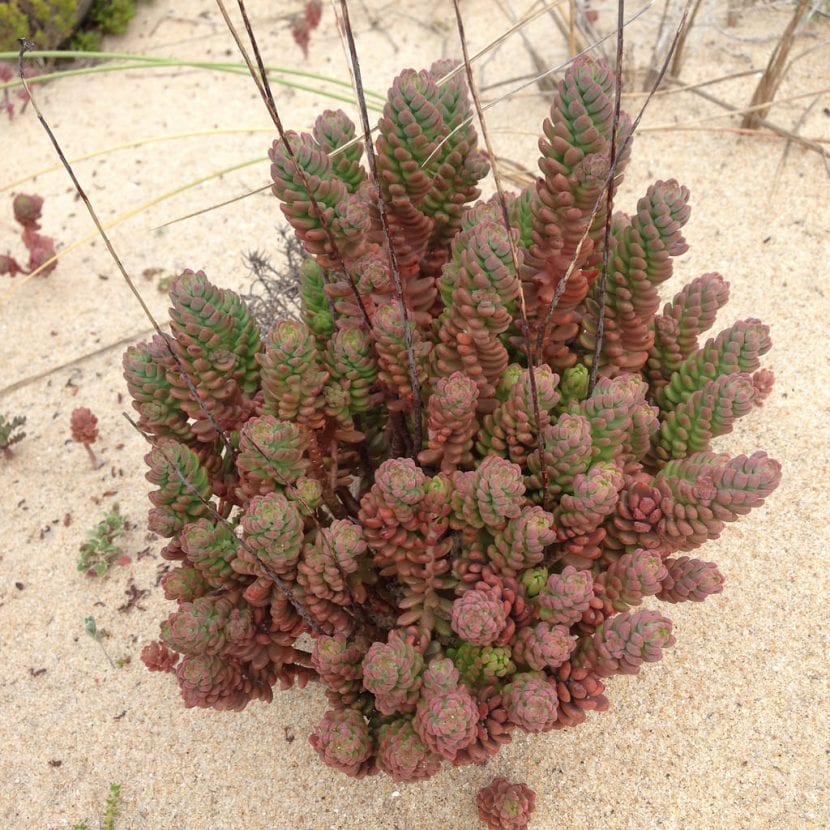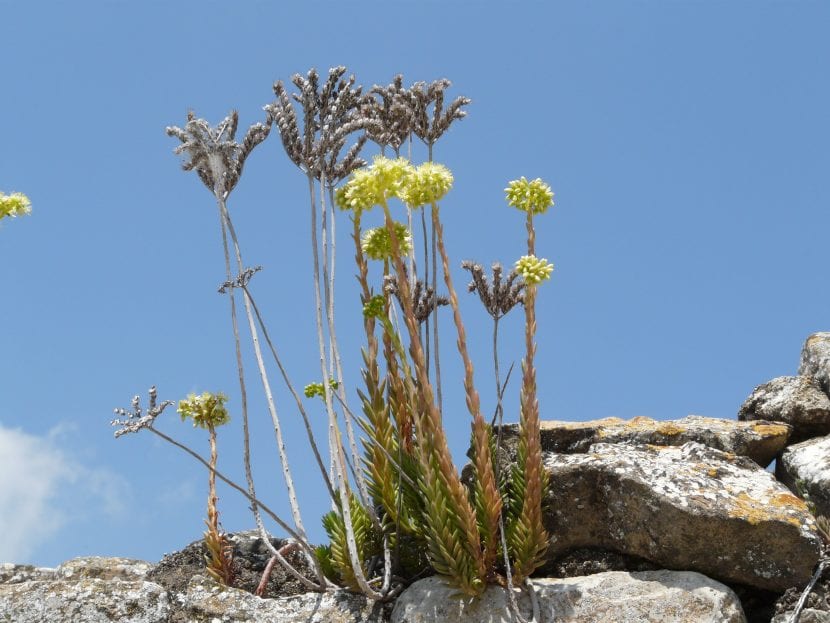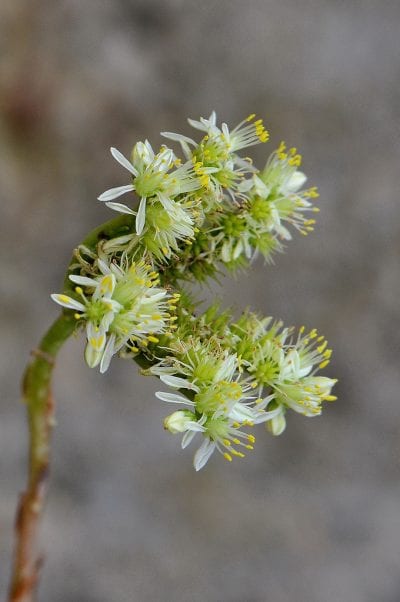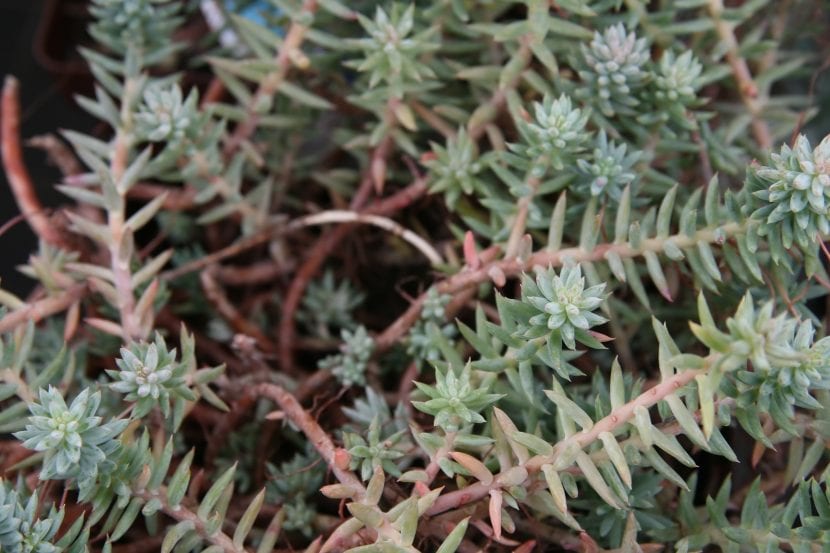
Non-cacti succulent plants have a reputation for being very resistant to drought, but the truth is that few are as resistant as the Sedum sediform. Being native to the Mediterranean region, where three months or more can go without rain at all, it is very well adapted to these extreme conditions.
So if you don't have a lot of time to take care of the plants but you are looking for one that is very decorative and resistant, continue reading to know everything about him Sedum sediform.
Origin and characteristics

El Sedum sediform, popularly known as cat's claw, vilano foot, pinillo, immortelle, lizard pinillo, or lizard nail, is a perennial crass plant native to the Mediterranean Region. Reaches a height of up to 40cm, and develops erect stems from which sprout fleshy oblong leaves of a glaucous greenish blue color.
The flowers are grouped in terminal inflorescences of up to 50cm. They are hermaphroditic, yellow in color and have five petals and five stamens each. Blooms in summer (July and August in the northern hemisphere).
What are their cares?
If you want to get a copy, we recommend providing the following care:
Location
El Sedum sediform it has to be outside, in full sun. It can also be in an interior patio as long as it is bright.
Earth
- Flower pot: universal culture substrate mixed with perlite in equal parts.
- Garden: the soil must be calcareous, with good drainage.
Irrigation
Very scarce. You have to water once a week in summer and every 15-20 days the rest of the year. In the case of having it in the garden, it will be enough to add a little water from time to time.
Subscriber
It is not necessary, but if you want you can pay with a liquid fertilizer for cacti and other succulents following the instructions specified on the product packaging.
Multiplication
Seeds
To multiply the Sedum sediform by seeds you have to do the following:
- First, a 10,5cm diameter pot is filled with universal growing substrate mixed with equal parts perlite.
- Second, it is watered so that it is well soaked.
- Third, the seeds are spread trying to be a little separated.
- Fourth, they are covered with a very thin layer of substrate and watered again, this time with a sprayer.
Keeping the substrate moist -but not waterlogged- the first seeds will germinate in 1-2 weeks at a temperature of 18-20ºC.
Stem cuttings
A faster and more efficient way to get new specimens is by multiplying it with stem cuttings in spring or summer. For it You just have to cut a piece and plant it in a pot with a universal growing medium mixed with 50% perlite..
Plagues and diseases
It usually does not have any problem or pests or diseases; However, during the rainy season you have to be careful with snails and slugs, since these mollusks love to eat tender and fleshy shoots. In addition, if the root system is watered excessively, it would rot, and with it the leaves, which would end up falling.
Planting or transplanting time

The best time to transfer it to the garden or a pot about 2-3cm larger is in spring, when the risk of frost has passed.
Rusticity
El Sedum sediform resists cold and frost up to -7ºC.
What uses does it have?
Ornamental
This is a very decorative succulent plant, which it can be had both in pot and in the garden. Regardless of where it is placed, if it is directly exposed to the sun, it will look great. In addition, as it is very easy to take care of, you just have to sit down to contemplate it and enjoy its beauty 🙂.
Medicinal
Yes, it has very interesting medicinal properties. In fact, it is used for all this:
- Cure gastritis and stomach ulcers: the leaves are chopped with a mortar, serene is added and the next day they are strained with a cloth and taken on an empty stomach.
- For jaundice: the leaves are chopped in a mortar, they are put to soak with serene water, and the next day they are strained to be taken on an empty stomach. The treatment must be repeated for 8 more days.
- As an emollient: to soften corns and bunions, put the fresh and crushed plant on top.
- Against heartburn: for this, it will be enough to chew a sprout or a few leaves while they are swallowed little by little.
- Relieve toothache: the treatment will consist of crushing some leaves and sucking them.
- As an anti-inflammatory: the leaves are crushed and the juice is applied to the inflammation.
Culinary
The leaves can be consumed fresh or washed, in salads or alone. It is advisable to harvest them in spring, before they are gleaned (April in the northern hemisphere).

And with this we are done. What did you think of the Sedum sediforme? Have you ever seen it in the field?